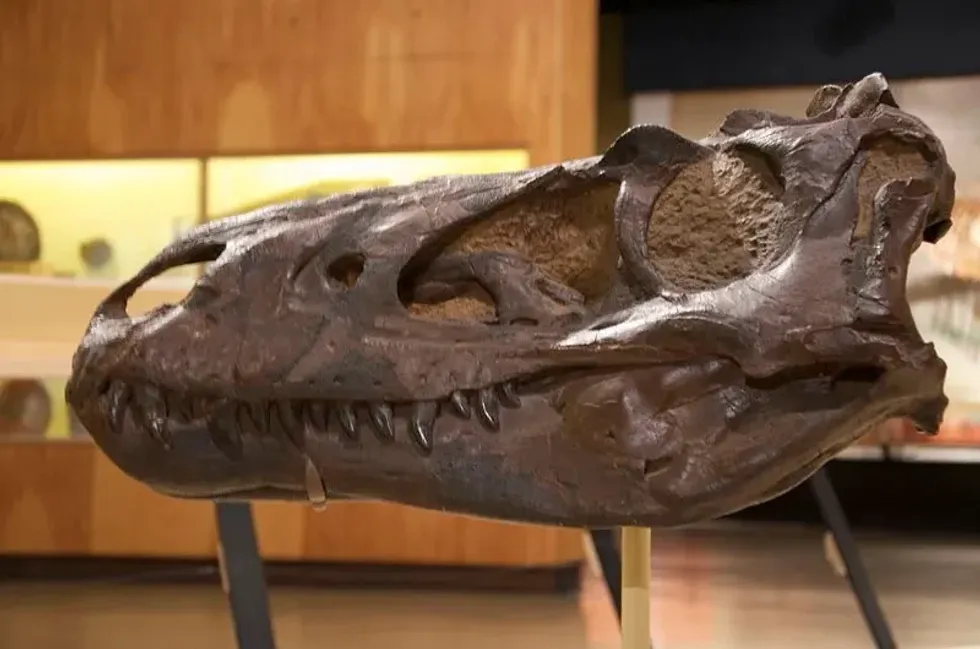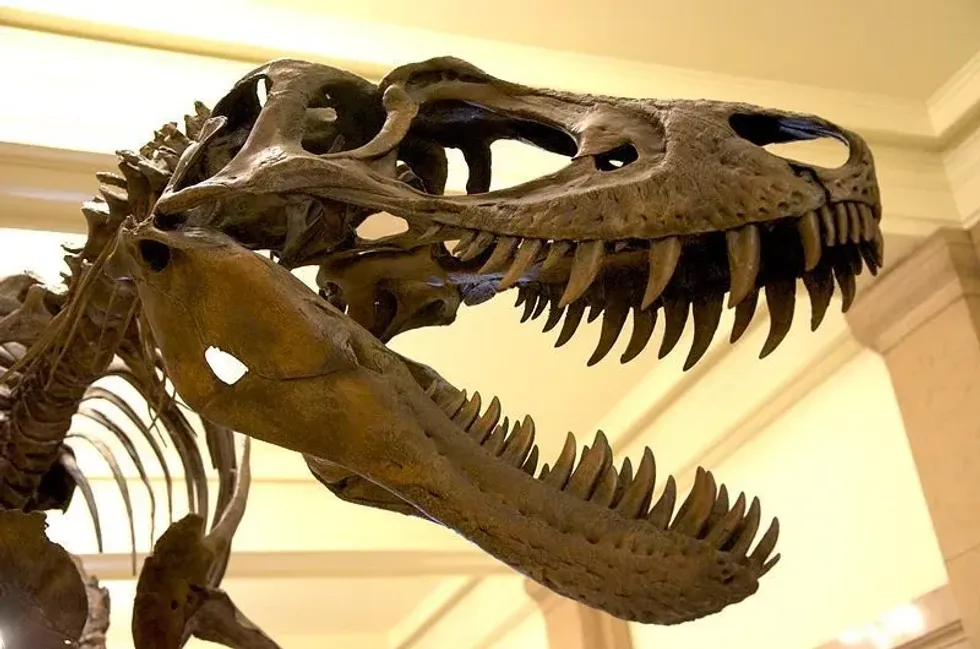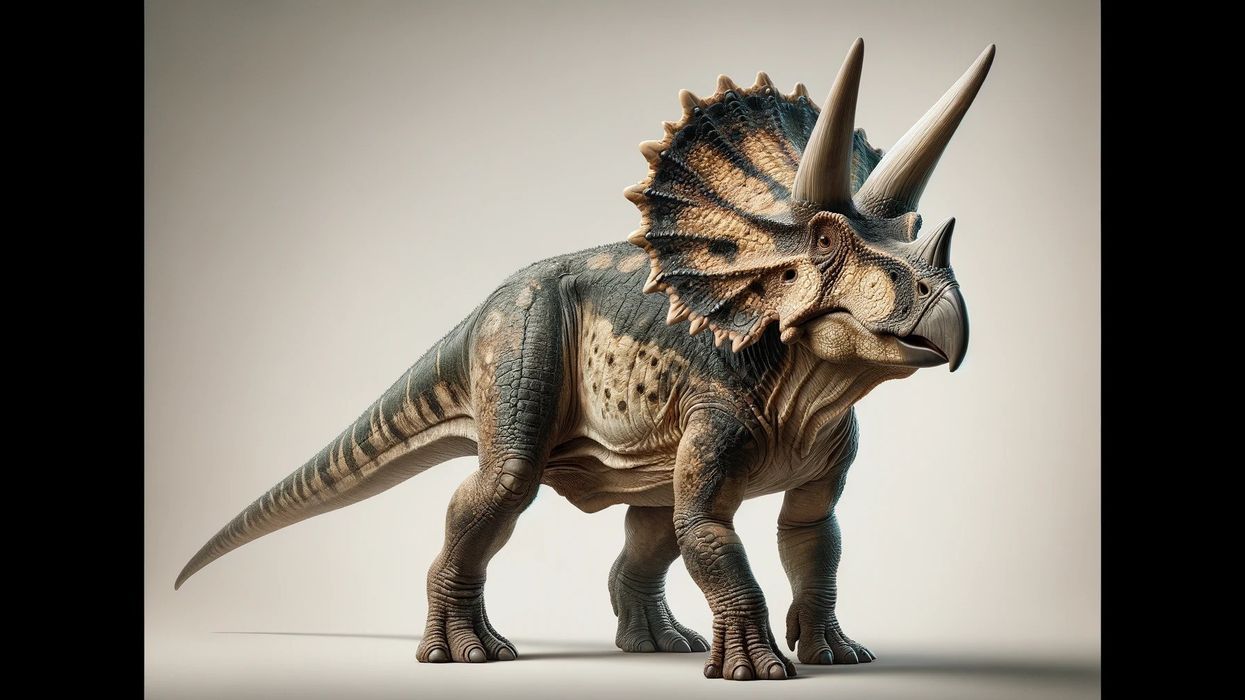Fun Nanotyrannus Facts For Kids
The Nanotyrannus lancensis belongs to the genus Tyranosauridae and it's a dubious genus of the tyrannosaurid dinosaur. It is one of the smallest tyrannosaurid dinosaurs to exist during the Late Cretaceous period which was 72.1-66 million years ago.
The meaning of the genus name Nanotyrannus is a 'dwarf tyrant'. The name was kept to signify its small size in comparison to the other tyrannosaurids. The dinosaur species lived in present-day western North America along with other tyrannosaurid species.
The first fossil specimen of this tyrannosaurid was discovered by the curator of the Cleveland Museum of Natural History in 1942. Dr. David Dunkle found a small but nearly complete skull in the Upper Lance Formation, which is now known as the Hell Creek Formation.
This fossil specimen was described and identified in 1946 under the genus Gorgosaurus by Charles W. Gilmore. Phil Currie changed the description to Clevelanotyrannus in 1987.
The current genus name was given by Robert T. Bakker in 1981. Michael Williams (1988) was the last curator of paleontology at the Cleveland Museum of Natural History.
Phil Currie and Michael Williams (1988) put the specimen found on display. Along with Robert T.Bakker, Phil Currie published a paper, describing the new genus Nanotyrannus, which means a new genus of pygmy tyrant.
Even after the naming of the specimens, there was still further research and it was observed by scientists if that the specimen belonged to a juvenile Tyrannosaurus rex.
In 2001, more specimens were found due and scientists are torn between the idea that the Nanotyrannus lancensis being a juvenile Tyrannosaurus rex. The old fossils were therefore nicknamed Jane, after the discovery of new fossils.
Many scientists believe that the skull found belongs to a juvenile Tyrannosaurus rex, while minor differences between the two species make it difficult for paleontologists to accept it to be a younger Tyrannosaurus rex.
There are many paleontologists who contradict this theory and have claimed that the fossils found were just a part of the adult T-rex, but the specimen found is just of a younger rex, which didn't have its period of growth and therefore had the same features as the adult T-rex and yet was small.
Currie and Henderson after the conference on tyrannosaurs in 2005, focused on the evidence if the Nanotyrannus was valid.
The Jane specimen was observed in the Burpee Museum of Natural History and several paleontologists along with Currie and Henderson saw the Jane specimen to be proof that the Nanotyrannus was a juvenile Tyrannosaurus rex or a close relative.
Scroll down to read about the Nanotyrannus's life, what they fed on, their habits, and other exciting details! If you want to discover more like the Nanotyrannus, take a look at the Chilantaisaurus and Chungkingosaurus.
Nanotyrannus Interesting Facts
How do you pronounce 'Nanotyrannus'?
The term Nanotyrannus should be pronounced as 'Nan-o-tie-ran-us'.
What type of dinosaur was a Nanotyrannus?
The Nanotyrannus dinosaur was a carnivorous predator and belonged to the dubious genus of the tyrannosaurid dinosaur. It existed during the Late Cretaceous period which was 72.1-66 million years ago.
The dinosaur species lived in present-day Western North America along with other tyrannosaurid species. Phil Currie and Michael Williams (1988) put the fossil specimen found on display in the Cleveland Museum of Natural History. More bone specimens of the dinosaur were found and therefore the old fossils were nicknamed Jane, after the discovery of new fossils.
In which geological period did the Nanotyrannus roam the Earth?
It existed during the Late Cretaceous period which was 72.1-66 million years ago.
When did the Nanotyrannus become extinct?
Dinosaurs, in general, went extinct almost 65 million years ago at the end of the Cretaceous period, after living on Earth for about 165 million years. This species however belonged to the Late Cretaceous period which was 72.1-66 million years ago. It was one of the last tyrannosaurids to exist before the extinction of the dinosaurs.
Where did a Nanotyrannus live?
This dinosaur species inhabited the present-day area of western North America during the Late Cretaceous period. The tectonic plates started to shift during the era of dinosaurs and therefore the area in which they lived might have varied at that time.
What was a Nanotyrannus' habitat?
Being carnivorous dinosaurs, they might have lived in areas that were terrestrial and yet had vegetation so that they could find suitable prey. The Nanotyrannus lancensis fed on smaller sauropods and stegosaurs and therefore might have inhabited areas that were cool and had dense vegetation.
Who did a Nanotyrannus live with?
This Cretaceous period dinosaur species was a member of the tyrannosaurid genus, which means it was one of the most feared predators amongst the dinosaurs. Due to this theory, it was assumed that the juvenile T-rex preyed solitarily.
But new studies contradict this, and there has been significant proof that juvenile T-rex dinosaurs hunted in packs with their own species or other same size predators.
How long did a Nanotyrannus live?
There is no mentioned data on the lifespan of the dinosaur, but we can assume it had a similar lifespan to other tyrannosaur dinosaurs. Tyrannosaurs survived for 20-30 years so it predicted that the the Nanotyrannus also survived within this time span.
How did they reproduce?
Tyrannosaurid dinosaurs, much like other reptiles, mated with each other during the breeding season and in the case of this breed, the female dinosaur laid eggs. The Nanotyrannus lancensis eggs hatched after a certain period of time and newborn dinosaurs came out.
The adult dinosaurs took care of the young ones until they could move with their parents or go along with their new family.
Nanotyrannus Fun Facts
What did a Nanotyrannus look like?
The holotype skull of the juvenile tyrannosaur new species was found to have fused skull bones. Studies showed that when skull bones are fused, the fossils can indicate the age of the dinosaur and it was, therefore, declared that it's an adult specimen.
After this research came out, Bakker and his colleagues assigned the skull to a new genus which was named Nanotyrannus because of its small size. The discovered fossils of the dinosaur weren't much, and the skull was small and nearly complete.
The Nanotyrannus skull had a broad and boxy skull and a thin and wide snout. At the inner portion of the snout, the dinosaur had blade-like teeth.
The sharp teeth could rip off the flesh of other dinosaurs like ankylosaurids, Triceratops, hadrosaurs, Ankylosaurs, and more sauropods.
It had a longer eye socket over the upper snout and a straight cheekbone, which was seen as a unique feature. The species had many similar features as tyrannosaurs and it was discovered that the features were similar to that of the Tyrannosaurus rex, not other tyrannosaurids.
At first, after the discovery of the fossils, it was stated that the skull bone was fused, but after further evidence was provided, it was stated that the bone wasn't fused and therefore the discovered skull was of a juvenile and not an adult.

How many bones did a Nanotyrannus have?
As the only discovery for the Nanotyrannus is their skull and there has been no discovery of the Nanotyrannus skeleton as of yet, the number of bones cannot be assumed for the species. Only after the skeleton of the dinosaur is found of the carnivore species can valid data be produced.
The first fossil specimen was discovered by the curator of the Cleveland Museum of Natural History in 1942.
How did they communicate?
There is no specific mention of how they communicated as it is quite difficult to know, but they definitely didn't have modern means of communication. Like any other animal, dinosaurs also communicated by making sounds and using their body language.
These might have included hoots and hollers to communicate. Being ravenous predators, the tyrannosaurid dinosaur had a high-pitched growl that helped to call for help during hunting.
How big was a Nanotyrannus?
The Nanotyrannus size as claimed by Bakker and other paleontologists was only half of the actual size, as Jane died at the age of 11.
Due to this early death, the Nonotyrannus didn't reach its full growth to become a Tyrannosaurus rex. This Tyrannosauridae species was about 196 in (5 m) in length and 78 in (2 m) in height.
This makes it almost two times smaller in length than the Torvosaurus which is 393.7 in (10 m) in length and about one times smaller in height as the latter was about 98.4 in (2.5 m) in height.
How fast could a Nanotyrannus move?
Even though the Nanotyrannus is stated to be a juvenile rex, the assumed Nanotyrannus top speed is almost 40-50 mph (64.3-80.4 kph) which is about 10-20 mph (16-32.1 kph) faster than the Tyrannosaurus rex. The carnivore dinosaur had a superb vision and could run with long and fast strides, overtaking its prey.
How much did a Nanotyrannus weigh?
The Nanotyrannus weight was almost 1984 lb (900 kg) and this makes it about 10 times heavier than the Latenivenatrix which weighed almost 6.6 lb (3 kg).
What were the male and female names of the species?
There is no specific name for the male or female dinosaurs of this tyrannosaur species and are commonly known as Nanotyrannus, Nanotyrannus lancensis, and Juvenile Tyrannosaurus rex.
What would you call a baby Nanotyrannus?
The newborn dinosaur was known as hatchling or nestling. This was common for most dinosaur species. There is no specific information on the names of newborns for this species as of now.
What did they eat?
These tyrannosaurs were the biggest predators amongst the dinosaurs and Nanotyrannus carnivores, being a young tyrannosaurus rex, were also one of the most ravenous predators. The Nanotyrannus diet consisted of most herbivorous dinosaurs like ankylosaurids, Triceratops, hadrosaurs, Ankylosaurs, and more sauropods.
These Cretaceous period dinosaurs sometimes even attacked theropod dinosaurs in order to feed on during brawls or lack of food.
How aggressive were they?
The Tyrannosauridae genus animals were the biggest predators amongst the dinosaurs throughout the era in which dinosaurs and other reptiles existed. They were the most aggressive dinosaurs to exist and would prey on most of the dinosaurs that existed. They even attacked other carnivorous dinosaurs which were smaller than them, in order to secure territory or during hunting.
Did you know...
In 2020, there were other study references by Woodward that stated that the Nanotyrannus didn't have developed features like the tyrannosaur and therefore due to lack of growth, the dinosaur had some missing bones and therefore didn't resemble the tyrannosaur completely.
But due to being ontogenetically being immature, the specimen surely did point that the skull belonged to a juvenile T-rex.
Is the Nanotyrannus its own species?
The Nanotyrannus belongs to the Tyrannosaur genus and is stated to be a juvenile T-rex. While this is still debatable, the dinosaur is surely its own genus. The dinosaur belongs to the family of tyrannosaurs, but as stated by Robert T.Bakker and Phil Currie, this is a different genus.
How big is the Nanotyrannus compared to other dinosaurs?
The Nanotyrannus was the smallest among the genus Tyrannosauridae, but it was bigger than most other dinosaurs. As the Nanotyrannus died at the age of 11, it didn't achieve its full growth and therefore the Nanotyrannus size comparison is difficult, but even being a juvenile it was bigger than most cretaceous period dinosaurs.
Here at Kidadl, we have carefully created lots of interesting family-friendly dinosaur facts for everyone to discover! Learn more about some other creatures from our Xenotarsosaurus facts, or Puertasaurus facts for kids pages.
You can even occupy yourself at home by coloring in one of our free printable Nanotyrannus coloring pages.
Main image by ScottRobertAnselmo
Second image by ScottRobertAnselmo
We Want Your Photos!
More for You
Bachelors in Business Administration

Aashita DhingraBachelors in Business Administration
Based in Lucknow, India, Aashita is a skilled content creator with experience crafting study guides for high school-aged kids. Her education includes a degree in Business Administration from St. Mary's Convent Inter College, which she leverages to bring a unique perspective to her work. Aashita's passion for writing and education is evident in her ability to craft engaging content.
Disclaimer
1) Kidadl is independent and to make our service free to you the reader we are supported by advertising. We hope you love our recommendations for products and services! What we suggest is selected independently by the Kidadl team. If you purchase using the Buy Now button we may earn a small commission. This does not influence our choices. Prices are correct and items are available at the time the article was published but we cannot guarantee that on the time of reading. Please note that Kidadl is a participant in the Amazon Services LLC Associates Program, an affiliate advertising program designed to provide a means for sites to earn advertising fees by advertising and linking to Amazon. We also link to other websites, but are not responsible for their content.
2) At Kidadl, we strive to recommend the very best activities and events. We will always aim to give you accurate information at the date of publication - however, information does change, so it’s important you do your own research, double-check and make the decision that is right for your family. We recognise that not all activities and ideas are appropriate for all children and families or in all circumstances. Our recommended activities are based on age but these are a guide. We recommend that these ideas are used as inspiration, that ideas are undertaken with appropriate adult supervision, and that each adult uses their own discretion and knowledge of their children to consider the safety and suitability. Kidadl cannot accept liability for the execution of these ideas, and parental supervision is advised at all times, as safety is paramount. Anyone using the information provided by Kidadl does so at their own risk and we can not accept liability if things go wrong.
3) Because we are an educational resource, we have quotes and facts about a range of historical and modern figures. We do not endorse the actions of or rhetoric of all the people included in these collections, but we think they are important for growing minds to learn about under the guidance of parents or guardians.







